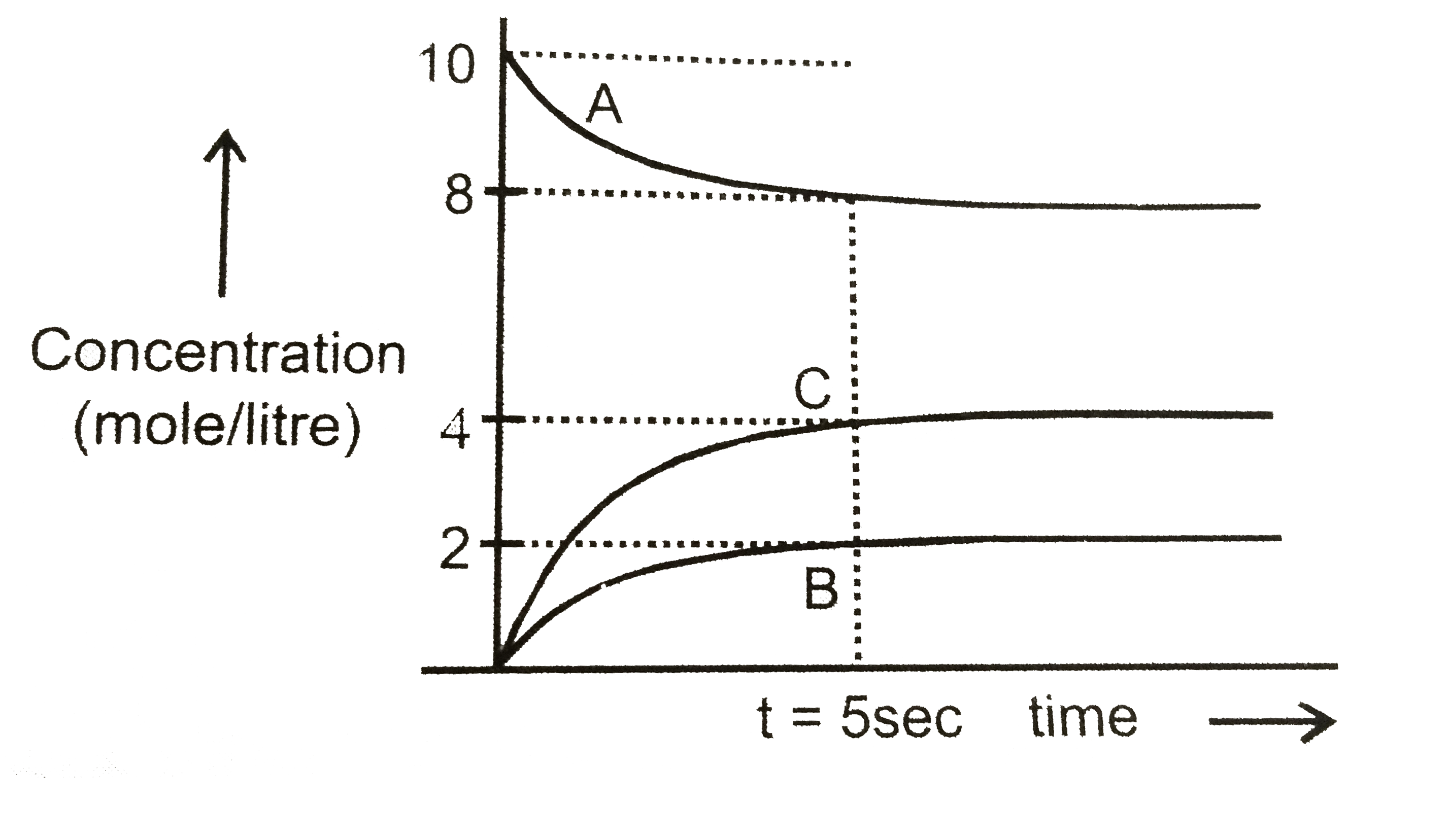Attainment of the equilibrium A(g)⇔2C(g)+B(g)gave the following graph . Find the correct option .(% dissociation=Fration dissoiated×100)
 Solution in Telugu
Solution in Telugu
At t=5 sec equilibrium has been reached and Kc=40(mol/litre)2
At t=5 sec equilibrium has been reached and % dissciation of A is 20%
At t=5 sec equilibrum has been reached and % dissocition of A is 30%
none of these
The correct Answer is:b
Step by step video & image solution for Attainment of the equilibrium A(g)hArr2C(g)+B(g)gave the following graph . Find the correct option .(% dissociation=Fration dissoiatedxx100) by Chemistry experts to help you in doubts & scoring excellent marks in Class 11 exams.
Updated on:21/07/2023Topper's Solved these Questions
- CHEMICAL EQUILIBRIUMBOOK - NARENDRA AWASTHICHAPTER - CHEMICAL EQUILIBRIUMEXERCISE - Level 1 (Q.93 To Q.122)
1 Videos
- CHEMICAL EQUILIBRIUMBOOK - NARENDRA AWASTHICHAPTER - CHEMICAL EQUILIBRIUMEXERCISE - Level 2
1 Videos
- ATOMIC STUCTUREBOOK - NARENDRA AWASTHICHAPTER - ATOMIC STUCTUREEXERCISE - level 2
1 Videos
- DILUTE SOLUTIONBOOK - NARENDRA AWASTHICHAPTER - DILUTE SOLUTIONEXERCISE - Level 3 - Match The Column
1 Videos
Similar Questions
An equilibrium mixture at 700 K of 0.05M N2(g)and0.2MNH3(g) is present in a container .Now if this equilibrium is disturbed by adding N∘ (g) so that its concentration becomes 0.15M just after addition then which of the following graph represents the above situation more appropriately:
View SolutionCalculate ΔrG for the reaction at 27∘C
H2(g)+2Ag+(aq)⇔2Ag(s)+2H+(aq)
Given : PH2=0.5 bar, [Ag+]=10−5M,
[H+]=10−3M,ΔrG∘[Ag+(aq)]=77.1kJ/mol
View SolutionA small particle of mass m moves in such a way that the potential energy U = ar2 where a is a constant and r is the distance of the particle from the origin. Assuming Bohr's model of quantization of angular momentum and circular orbits, find the radius of nth allowed orbit.
View SolutionColumn -I and Column -II contain four entries each. Entries of column-I are to be matched with some entries of column-II. One or more than one entries of column-I may have the matching with the same entries of column-II.

View Solution2mol each of A and B are taken in a container to carry out the following reaction: 2A(g)+B(g)hArr2C(g)+2D(g) When the system attains equilibrium, we have
View SolutionIn the following reaction, 3A(g)+B(g)⇔2C(g)+D(g), Initial moles of B is double at A . At equilibrium, moles of A and C are equal. Hence % dissociation is :
View SolutionAttainment of the equilibrium A(g)⇔2C(g)+B(g)gave the following graph . Find the correct option .(% dissociation=Fration dissoiated×100)

View SolutionAt a given temperature equilibrium is attained when 50% of each reactant is converted into the products A(g)+B(g)hArrC(g)+D(g) If amount of B(g) is doubled, percentage of B converted into products will be :-
View SolutionIn the reaction AB(g) hArr A(g) + B(g) at 30^(@)C, k_(p) for the dissociation equilibrium is 2.56xx10^(-2) atm . If the total pressure at equilibrium is 1 atm, then the percentage dissociation of AB is
View SolutionThe equilibrium A(g)+4B(g)⇔AB4(g) is attained by mixing equal moles of A and B in a one litre vessel Then at equilibrium
View SolutionAttainment of the equilibrium A(g)hArr2C(g)+B(g) gave the following graph . Find the correct option . (% dissociation=Fration dissoiatedxx100)
View SolutionK_p for the reaction N_2O_4(g) leftrightarrow 2NO_2(g) at 750K is 640torr. Calculate the percentage of dissociation of N_2O_4 at equilibrium pressure of 160torr.
View Solution0.196 g of an organic compound gave 0.22 g of CO2 and 0.0675 g of H2O. In carius determination, 0.3925 g of the substance gave 0.717 g of dry AgCl. Find the percentage composition of the substance.
View Solution0.196 g of an organic compound gave 0.22 g of CO2 and 0.0675 g of H2O. In carius determination, 0.3925 g of the substance gave 0.717 g of dry AgCl. Find the percentage composition of the substance.
View Solution256 g of HI were heated in a sealed bulb at 444°C till the equilibrium was attained. The acid was found to be 22% dissociated at equilibrium. Calculate the equilibrium constant for the reaction 2HI(g)⇔H2(g)+I2(g)
View SolutionThe value of KP for the equilibrium reaction N2O2(g)↔2NO2(g) is 2. The percentage dissociation of N2O2(g) at a pressure of 0.5 atm is
View Solution
